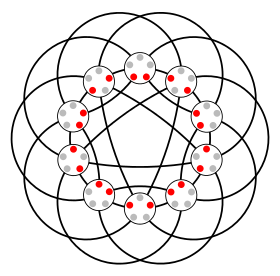Intersection array
As a consequence of being distance-transitive,  is also distance-regular. Letting
is also distance-regular. Letting  denote its diameter, the intersection array of
denote its diameter, the intersection array of  is given by
is given by

where:

It turns out that unless  is
is  , its intersection array is not shared with any other distinct distance-regular graph; the intersection array of
, its intersection array is not shared with any other distinct distance-regular graph; the intersection array of  is shared with three other distance-regular graphs that are not Johnson graphs.[1]
is shared with three other distance-regular graphs that are not Johnson graphs.[1]
Johnson scheme
The Johnson graph  is closely related to the Johnson scheme, an association scheme in which each pair of k-element sets is associated with a number, half the size of the symmetric difference of the two sets.[9] The Johnson graph has an edge for every pair of sets at distance one in the association scheme, and the distances in the association scheme are exactly the shortest path distances in the Johnson graph.[10]
is closely related to the Johnson scheme, an association scheme in which each pair of k-element sets is associated with a number, half the size of the symmetric difference of the two sets.[9] The Johnson graph has an edge for every pair of sets at distance one in the association scheme, and the distances in the association scheme are exactly the shortest path distances in the Johnson graph.[10]
The Johnson scheme is also related to another family of distance-transitive graphs, the odd graphs, whose vertices are  -element subsets of an
-element subsets of an  -element set and whose edges correspond to disjoint pairs of subsets.[9]
-element set and whose edges correspond to disjoint pairs of subsets.[9]
Open Problems
The vertex-expansion properties of Johnson graphs, as well as the structure of the corresponding extremal sets of vertices of a given size, are not fully understood. However, an asymptotically tight lower-bound on expansion of large sets of vertices was recently obtained.[11]
In general, determining the chromatic number of a Johnson graph is an open problem.[12]



































